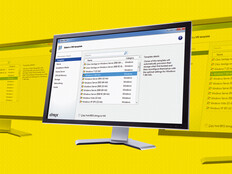Benefit vs. Cost for Healthcare VDI Deployments
As healthcare clinicians and staffers increasingly rely on mobile devices, on-demand access to applications becomes that much more critical to ensuring operational efficiency and fast, effective patient care. It should come as no surprise, therefore, that the global market for cloud-based virtual desktop infrastructure — which gives end users in various locations the ability to access hosted applications and files from their mobile device of choice — continues to rise.
According to a recent report from Allied Market Research, the cloud-based VDI market is expected to increase at a compound annual growth rate of 16.5 percent through 2023 to reach more than $10 billion.
A report published last spring by Login VSI found healthcare to be the top industry for VDI use.
So how are providers taking advantage of VDI?
SIGN UP: Get more news from the HealthTech newsletter in your inbox every two weeks!
VDI Offers Clinicians Anytime, Anywhere Access
At Southern New Hampshire Health System, its VDI setup has been a boon to patient care, according to Scott Tymowicz, a desktop-configuration engineer with the organization writing in the Data Center Journal. The organization, which relies on VMware Horizon View, built on a foundation that includes hyperconverged infrastructure technology from Pivot3, is now able to support clinician needs across roughly 200 desktops. That means patient data is available when and where providers need it.
Meanwhile, SCL Health, a faith-based nonprofit organization based in Broomfield, Colo., deployed Citrix's VDI technology, including XenMobile, to allow staff at 11 hospitals and 210 physician clinics anytime, anywhere access to the apps they need. That's important, as 65 percent of the organization's technology staff work remotely, according to CIO Dave Pecoraro, speaking last spring at the Citrix Synergy 2017 conference in Orlando, Fla., where it won the 2017 Citrix Innovation Award.
Pecoraro called the setup "consumer-friendly," and said SCL has plans to move to the Citrix Cloud to improve its security standing.
Irving, Texas-based CHRISTUS Health also deploys Citrix tools, including XenDesktop, to connect its remote staff. In particular, VDI allows CHRISTUS to hire coders in several states without giving location or access a second thought. Such a setup has also helped the organization — which operates more than 60 hospitals and long-term care facilities and also has clinics and outpatient centers in Arkansas, Georgia, Louisiana and New Mexico, as well as Chile, Colombia and Mexico — reduce its hardware costs.
Cost Considerations for VDI Deployments
While VDI deployments may hold the potential to cut hardware costs for organizations down the road, providers would be wise to not view such solutions as a panacea to reduce spending. Per the Login VSI report, the biggest challenge for organizations with their VDI environment was the overall cost reduction of the complete technology stack.
Adam Sherwood, an enterprise infrastructure architect at Tewksbury, Mass.-based Covenant Health, told HealthTech that the opportunities for cost avoidance don't happen all at once.
"When you implement VDI, do your best to understand beforehand, through tools such as workflow analysis, how best you can create and increase value for your organization," he said.
To that end, healthcare organizations should take a long view on VDI deployment. By approaching the investment holistically, from finding a strong vendor partner to shoring up infrastructure, providers will increase their likelihood of success.
This article is part of HealthTech’s MonITor blog series. Please join the discussion on Twitter by using #WellnessIT.










